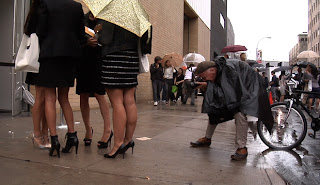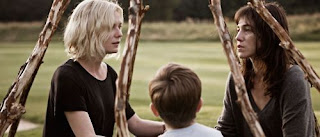Richard Press's documentary Bill Cunningham New York follows Bill, now over 80 years old, through his day to day life. We follow Bill on his bike, in his blue painter's smock, a camera slung over his neck, riding up and down Manhattan, in search of the moment when fashion presents itself. Bill never sets out to find the perfect picture but instead prides himself on letting the street speak to him, "The best fashion show is on the street, always has been, always will be". Through the snow, sleet, sun, rain, and whatever else mother nature has to offer, the street is always there and so is Bill.
Bill spends a lot of energy conveying the importance of the clothes, he insists that his point of view is not of any importance, claiming "it's not what i think, it's what i see." Bill lets the street tell him the story it wants to tell. Bill is just the messenger, but he is also a man who has given up his life to capture culture in New York for decades and because of Bill we have an unprecedented record of the ebbs and flows of fashion's epicenter.
Bill has remained a figure set permanently in the fashion industry while striving and insisting on standing in its fringes. His photos are meant to be fleeting moments that catch his subjects in all their unposed glory. His steadfast belief that money is the root of all evil has allowed him to dictate his career and life's journey any way that he so chooses. Bill says, quite eloquently, "If you don't take money, they can't tell you what to do kid, that's the key to the whole thing." He has never sold out and refuses to let anyone twist his work into anything other than pure observation.
In a interview from 1989, Bill beautifully expresses the need for fashion in a world fraught with wars, homelessness, sadness, and loneliness. He addresses those who believe that fashion is a frivolity that shouldn't be taken seriously in a world full of so much else but Bill insists, "Fashion is the armor that helps us to survive everyday life! I don't think you can do away with it, it would be like doing away with civilization". He insists that the mere existence of beauty allows for the world to find it.
This film must be seen by anyone who has ever craved to find their passion and once discovers it realizes that nothing else needs to exist as long as the path to that passion can be taken.
Bill's Column in The New York Times
Another signature Bill.
At war on the streets of NYC, capturing fashion as it happens.
On the front lines of the Parisian fashion shows
Whatever it takes to get the shot
Bill and his camera, in signature blue smock, which he wears purely for functionality
Bill's studio apartment, filled from floor to ceiling with filing cabinets of negatives
On the street















